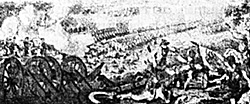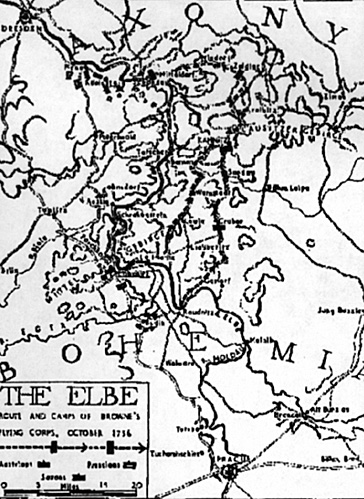 From Wild Goose and the Eagle. By Christopher Duffy.
From Wild Goose and the Eagle. By Christopher Duffy.
By 1:00 p.m. affairs had reached a crisis level for the Prussians. As the surviving Prussian cavalry retreated back to the Homolkaberg, and with the issue on the Loboschberg still in doubt, a sentiment akin to despondency permeated the Prussian command. Frederick, believing that the Austrians were preparing a counterattack, decided to quit the field in an eerie repetition of his performance at Mollwitz fifteen years earlier, although his royal person was in no immediate danger. Leaving the overall command in the hands of Keith, he gave orders for Bevern to renew the assault on the Loboschberg and for Keith to support this assault with his remaining infantry. With that, he departed "in order to take fresh measures" as the General Staff work diplomatically states.
This abandonment proved to be a blessing for Frederick's army, as Keith could now run things unvexed by his volatile and agitated sovereign. Gradually the Austrians, despite the reinforcements that General Lacy had thrown into the fray, were finally pushed off the Loboschberg and forced back through the burning streets of Lobositz. After an hour of the most intense fighting of the battle, the Austrians were at length forced out of the town. They retreated in good order. To maintain his contact with the Elbe and to buttress his right flank, Brown shifted his uncommitted left wing around to the plains behind Lobositz and Sullowitz.
This rear guard action saved his army and prevented the Prussians from making any serious attempt at exploiting their victory. By three o'clock the firing was over. Browne had succeeded in extracting all of his artillery save for three wrecked field pieces. Feeling his blocking mission accomplished, Browne ordered his army to fall back to the town of Budin. Frederick meanwhile was actually preparing orders for his army to retreat when he heard the news of the sudden reversal of fortune. The Prussians remained for some time at Lobositz giving Browne the opportunity that he needed to launch an expedition of 8,000 infantry and 800 cavalry for the relief of Pirna.
 From Wild Goose and the Eagle. By Christopher Duffy.
From Wild Goose and the Eagle. By Christopher Duffy.
Although the Prussian casualties of around 2,900-3,100 slightly exceeded those of the Austrians who lost 2,863, their possession of the field of battle rendered them the technical victors, at least in their own eyes. In reality, Browne had accomplished all his declared objectives and had merely reoccupied his camp, withdrawing in good order unhampered by the Prussians. Furthermore the Austrians had showed that they were not the same troops that Frederick was used to rolling over as he had during the War of the Austrian Succession. He was even shocked enough to seek Dutch mediation with a view toward peace before reverting to his usual contentious self somewhat later.
From Browne's perspective, he had accomplished all that he could have wished for at Lobositz and thus justifiably regarded it as a victory. He said later that but for a lack of initiative on the part of some of his subordinates, he might have been able to crush Frederick completely. On the Prussian side, it was that very admirable initiative of the subordinate commanders who saved the day for Frederick. Frederick admitted in a letter to his brother that he had totally misread the Austrian deployment. Given the Prussian king's poor performance, it is no wonder that Browne had but small regard for Frederick's abilities as a general.
As to Browne's objectives, the Prussians had been drawn off from Pirna, thus weakening the blocking force there, the enemy advance on Prague had been stopped, and a relief column had been dispatched to Pirna unnoticed by the Prussians. Browne was to lead this expedition himself. The Pirna expedition came to naught, however, with the poorly led and demoralized Saxons surrendering to the Prussians on October 14.
After a few more desultory movements on the parts of the respective armies, they both finally went into winter quarters. The campaign of 1756 in Bohemia had come to an end.
BIBLIOGRAPHY
Asprey, Robert, Frederick the Great: The Magnificent Enigma, New York, 1986.
Cogswell, Neil, ed., 1756: The War in Bohemia: the Journal of Horace St. Paul, Guisborough, 1996.
Dorn, G., & Engelmann, J., Die Schlachten Friedrichs des Grossen, Oldendorf, 1991.
Duffy, Christopher, The Army of Frederick the Great, Chicago, 1996.
Duffy, Christopher, The Army of Maria Theresa, New York, 1977.
Duffy, Christopher, Frederick the Great: A Military Life, New York, 1990.
Duffy, Christopher, The Wild Goose and the Eagle: A Life of General von Browne, 1705-1757, London, 1964.
Frederick the Great, Account of the Campaign of 1756 in Bohemia, Silesia, and Saxony by the King of Prussia, London, 1757, reprinted by Old Battlefields Press, 1998.
Mitford, Nancy, Frederick the Great, New York, 1970.
Preil, Arndt, Österreichs Schlachtfelder, Vol. II, Graz, 1991.
Showalter, Dennis E., The Wars of Frederick the Great, New York, 1996.
ERRATUM NOTE: Much to my embarrassment, I have discovered that the Austrian Order of Battle found on the "Seven Years War Battle Map #1 - Lobositz" sold through Old Battlefields Press has an omission. I left out the Austrian right wing cavalry of the first line under O'Donnell (see above). This will appear in corrected form on future maps. Those who own this map should use the corrected OB above. I'm sorry for the mistake. Eh, bien! La m--de se passe.
More Battle of Lobositz (historical)
Back to Seven Years War Asso. Journal Vol. XI No. 1 Table of Contents
Back to Seven Years War Asso. Journal List of Issues
Back to Master Magazine List
© Copyright 1999 by James J. Mitchell
This article appears in MagWeb (Magazine Web) on the Internet World Wide Web.
Other military history articles and gaming articles are available at http://www.magweb.com